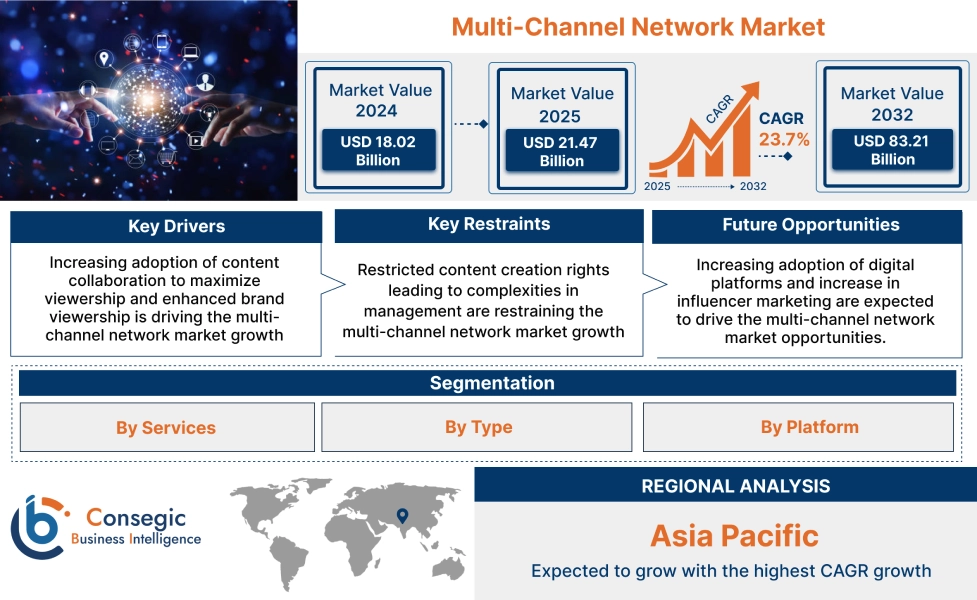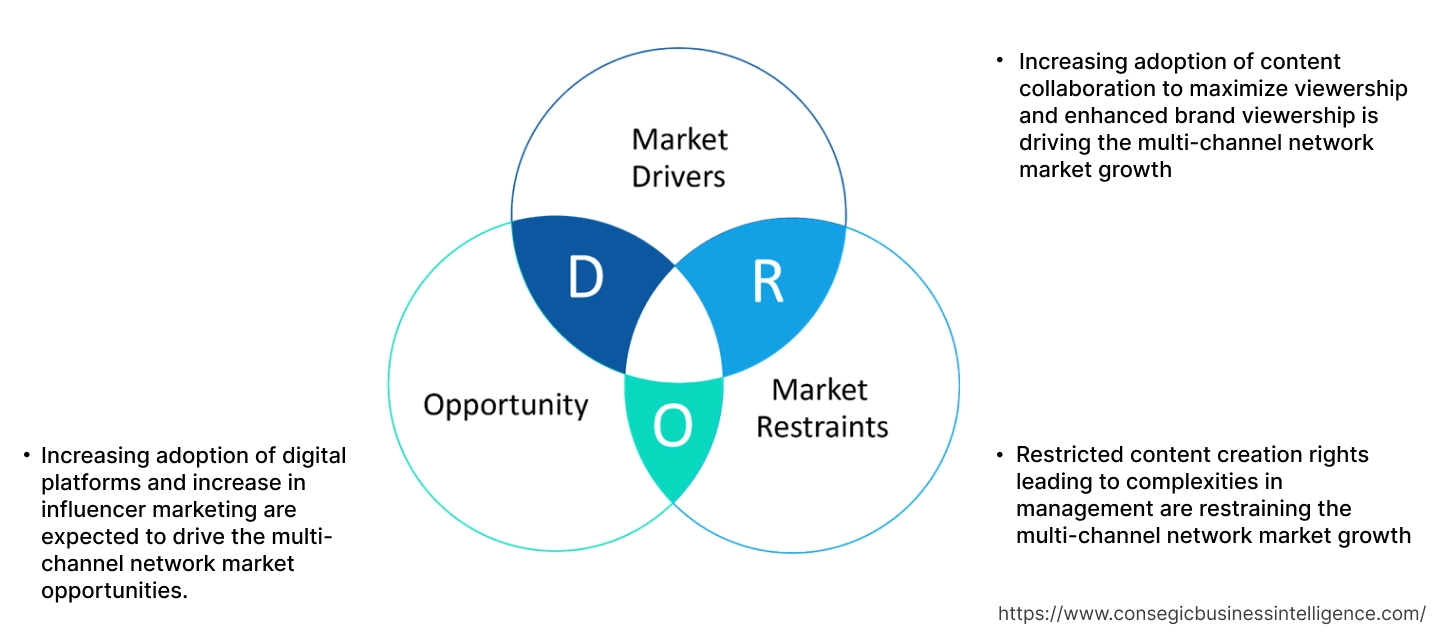Multi-Channel Network Market Size:
Multi-Channel Network Market size is estimated to reach over USD 83.21 Billion by 2032 from a value of USD 18.02 Billion in 2024 and is projected to grow by USD 21.47 Billion in 2025, growing at a CAGR of 23.7% from 2025 to 2032.
Multi-Channel Network Market Scope & Overview:
Multi-channel network (MCN) refers to a third-party provider that offers various channel services such as audience development, content creation, monetization, and others. Moreover, multichannel networks often manage monetary aspects, promotion, and legal aspects of the business. Additionally, the primary goal of multichannel networking is to expand individuals' earning potential by creating deals and generating endorsement deals. Furthermore, a multichannel network helps individuals in various areas such as programming, funding, cross-promotion, and others.
How is AI Transforming the Multi-Channel Network Market?
AI is revolutionizing the multi-channel network (MCN) market by improving content strategy, audience engagement, and monetization. With AI-driven analytics, MCNs can analyze viewer behavior, preferences, and engagement patterns to optimize content distribution across platforms like YouTube, TikTok, and Instagram. Machine learning models help creators identify trending topics, predict audience interests, and enhance video recommendations for higher visibility. AI also automates content tagging, copyright detection, and performance tracking, reducing manual effort and improving compliance. Furthermore, advanced algorithms assist in targeted advertising, maximizing revenue opportunities for creators and brands. As digital content consumption continues to surge, AI is empowering MCNs to operate more efficiently, deliver personalized experiences, and strengthen creator-brand partnerships globally.
Multi-Channel Network Market Dynamics - (DRO) :
Key Drivers:
Increasing adoption of content collaboration to maximize viewership and enhanced brand viewership is driving the multi-channel network market growth
Content collaboration involves teams and individuals to create, manage, and distribute content together. Moreover, effective collaboration increases influencers’ reach by aligning with influencers with similar values and target audience. Content creation significantly enhances brand viewership by expanding reach, boosting credibility, and fostering engagement. Additionally, the ability of multichannel networks to facilitate content reach and enable monetization opportunities is driving the multi-channel network market.
- For instance, Proofhub, a content collaboration platform, offers various features such as file sharing and version control, real-time feedback, centralized team communication, and others.
Thus, as per the multi-channel network market analysis, the above factors are driving the multi-channel network market size.
Key Restraints:
Restricted content creation rights leading to complexities in management are restraining the multi-channel network market growth
Multichannel network contracts restrict creators' ownership of their content, particularly if the MCN manages the operation of the channel. Moreover, a multichannel network handles monetization on behalf of affiliated channels, which does not let creators fully access their content. Additionally, violation of a multichannel network results in penalties and termination of partnership, further leading to complexities in management. Hence, restricted content creation leads to complexities in management within the multichannel network, which are further hindering the multi-channel network market expansion.
Future Opportunities :
Increasing adoption of digital platforms and increase in influencer marketing are expected to drive the multi-channel network market opportunities.
Digital platforms facilitate interactions between users and the target audience, often serving as a foundation for business operations and customer engagement. Moreover, influencer marketing helps increase reach, engagement and helps achieve business goals. Influencers help brands connect with consumers, leading to higher customer engagement. Additionally, the rise in content consumption across various digital platforms like social media and streaming services is driving the multichannel network market.
- For instance, according to Stats Counter, 62.81% of individuals utilized Facebook as a digital platform from March 2024 to March 2025.
Thus, increasing adoption of digital platforms and increase in influencer marketing are expected to drive the multi-channel network market opportunities during the forecast period.
Multi-Channel Network Market Segmental Analysis :
By Services:
Based on services, the market is segmented into audience development, content programming, monetization assistance, creator collaboration, and others.
Trends in the services:
- Rising trend in adoption of content collaboration due to increased content consumption and enhanced quality content is driving the multichannel network market.
- Factors including increased revenue potential and simplified monetization are driving the utilization of monetization assistance in the multi-channel network market.
Monetization assistance segment accounted for the largest revenue share of 32.30% in the overall multi-channel network market share in 2024.
- In multichannel networking, monetization assistance refers to the services offered by a multichannel network to help individuals generate revenue from their content.
- Moreover, multichannel networks often have connections with brands that are willing to provide and can negotiate with better terms due to their size and network.
- Additionally, multi-channel networks handle the administrative and logistic aspects of monetization, freeing up content creators.
- For instance, Fiver provides guidance and various tools for freelancers to monetize their skills, which allows creators to profit from the content that they create.
- Thus, monetization assistance services offered by multi-channel networks are accelerating the multi-channel network market size.
Creator collaboration segment is anticipated to register the fastest CAGR growth during the forecast period.
- Creator collaboration refers to a partnership between individuals within the network, which involves teaming up to promote content together.
- Moreover, creator collaboration often provides various benefits such as increased brand reach, target audience, and authentic promotion.
- For instance, Adobe launched a free app named Content Authenticity, which offers several benefits, including content collaboration. Moreover, this app allows digital creators to accurately identify attribution for their work before they make it public.
- Therefore, the increasing utilization of creator collaboration in multi-channel networks is expected to propel the multi-channel network market expansion during the forecast period.
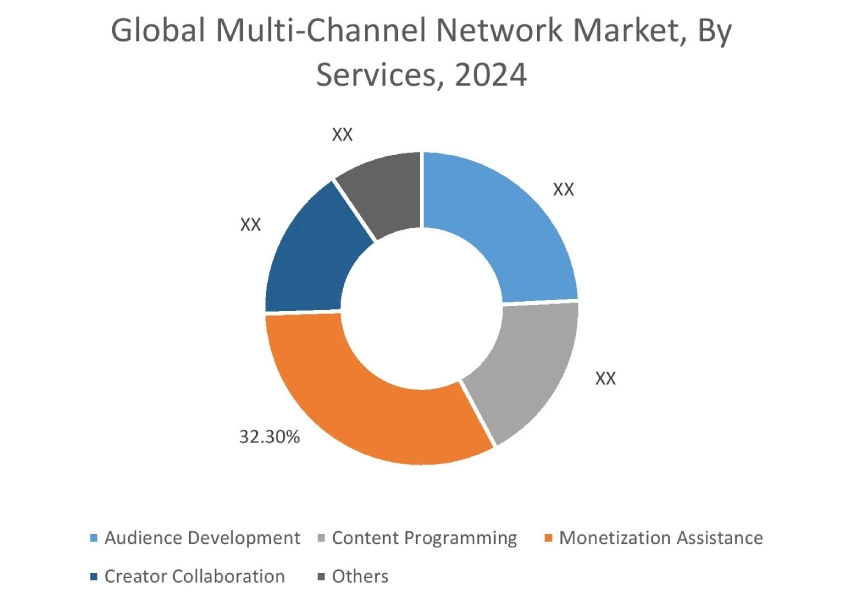
By Type:
Based on type, the market is segmented into affiliated and owned and operated.
Trends in the type:
- The rising trend in adoption of affiliated type channels for improved visibility and audience reach is driving the multichannel network industry.
- Factors such as ease of access to experts, enhanced monetisation, and increased networking and collaboration features are driving the market.
The affiliated segment accounted for the largest revenue share in the overall multi-channel network market share in 2024, and it is anticipated to register substantial CAGR growth during the forecast period.
- In a multi-channel network, an affiliated type of channel refers to an association between a digital platform and a larger entity to expand resources and reach for growth.
- Moreover, affiliation offers various benefits such as increased reach, brand reach, operational support, and access to an additional revenue system, which is further driving the market.
- For instance, in August 2022, Shopify Collabs, an affiliated marketing platform, was launched,which integrates with Dovetale’s features for an upgraded experience.
- Thus, the rising advancement related to the affiliated segment is expected to propel the market during the forecast period.
By Platform:
Based on platform, the market is segmented into YouTube, Instagram, TikTok, Facebook, and others.
Trends in the platform:
- Factors such as monetization, revenue generation, and content management are driving the multi-channel network market trends.
YouTube segment accounted for the largest revenue in the overall market in 2024.
- YouTube is an online video-sharing platform where users can share, watch, and upload videos.
- Moreover, a multichannel network helps users to manage and grow their content by offering a wide range of services such as monetization, audience development, and content promotion.
- For instance, according to Google Playstore, the YouTube app has downloads of more than 10 billion.
- Thus, the rising integration of multichannel networks with the YouTube platform, due to its ability to increase reach and visibility, is further driving the market growth.
Instagram segment is anticipated to register the fastest CAGR growth during the forecast period.
- Instagram is a photo and video sharing app with enhanced artificial intelligence features that help users connect globally.
- Moreover, multichannel networks help content creators on Instagram manage and grow their online content and connect with other creators and advertisers.
- For instance, according to Meta, the daily active people count of all Meta platforms, including Instagram, Facebook, and others, reached 2.96 billion in the year 2022, with an increase of 5% over a year.
Regional Analysis:
The regions covered are North America, Europe, Asia Pacific, Middle East and Africa, and Latin America.
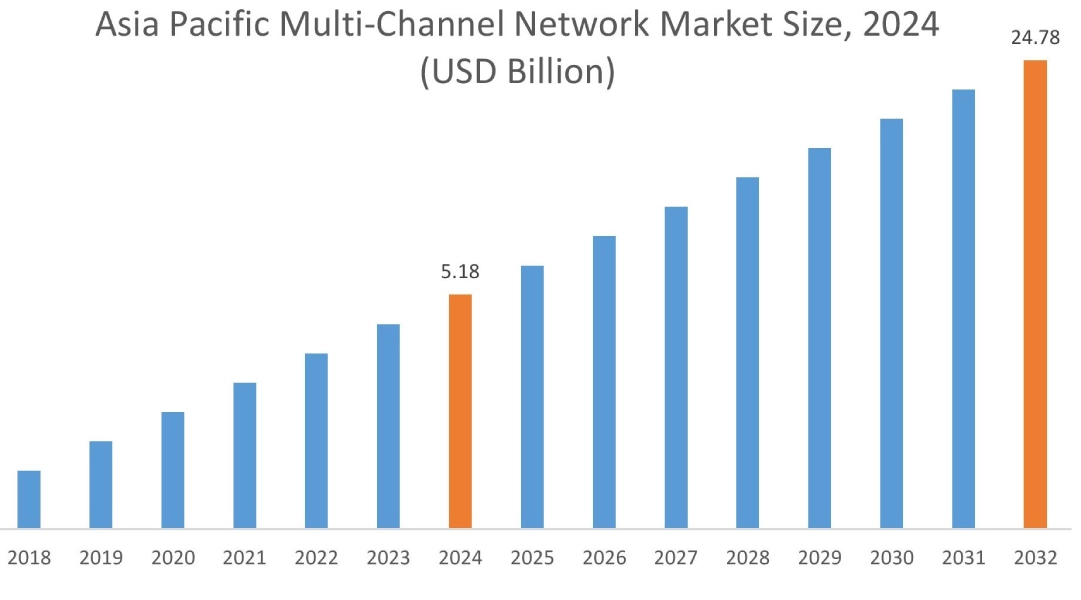
Asia Pacific region was valued at USD 5.18 Billion in 2024. Moreover, it is projected to grow by USD 6.19 Billion in 2025 and reach over USD 24.78 Billion by 2032. Out of this, China accounted for the maximum revenue share of 30.65%. As per the multi-channel network market analysis, there is an increasing demand for multichannel networks in the Asia-Pacific region for improving cross-promotion in creator collaboration. Additionally, factors including enhanced collaboration on YouTube along with wider audience reach are further driving the multi-channel network market demand.
- For instance, Qyuki Digital Media , Indian based multichannel network company, provides a range of services such as optimization, monetization, content strategy, collaboration, and others, which help creators build brands and connect with audiences through various platforms.
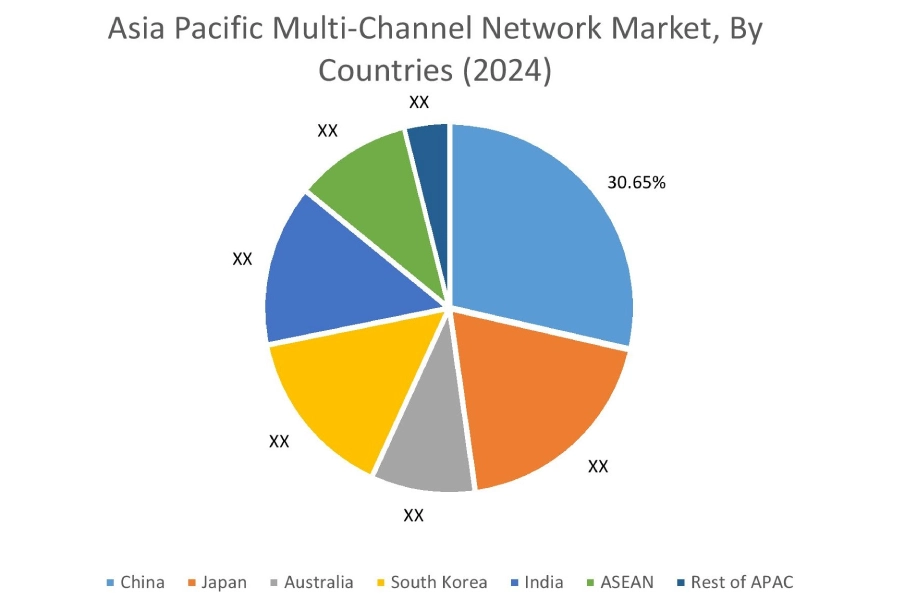
North America is estimated to reach over USD 29.95 Billion by 2032 from a value of USD 6.49 Billion in 2024 and is projected to grow by USD 7.73 Billion in 2025. In North America, the growth of the market is driven by increasing adoption of creator collaboration along with rising need for monetization assistance services in the region. As per the analysis, rising advancements related to multichannel networks are further contributing to the market expansion.
- For instance, in December 2022, Meta’s family of apps, which includes Facebook, Instagram, Messenger, and WhatsApp, generated a revenue of USD 114,450 million, with a count of 79% of daily active people worldwide.
Additionally, the regional analysis depicts the increased brand building and community management on Instagram, enhanced content adapting strategies, and growing need for ensuring compliance with laws and regulations related to online video platforms are driving the multi-channel network market demand in Europe. Further, as per the market analysis, the market in Latin America, Middle East, and African regions is expected to grow at a considerable rate due to enhanced collaboration between creators and rising demand for monetization assistance services to provide access to sponsorships, brand deals, and diversified revenue, among others.
Top Key Players and Market Share Insights:
The global multi-channel network market is highly competitive, with major players providing solutions to the national and international markets. Key players are adopting several strategies in research and development (R&D), product innovation, and end-user launches to hold a strong position in the multi-channel network industry. Key players in the multi-channel network industry include –
- One Digital Entertainment (India)
- Co-Sender Group (U.S.)
- Roqad (U.S.)
- Zefr Inc (U.S.)
- Vevo LLC (U.S.)
- Universal Music Investments, Inc. (U.S.)
- Vaz Inc. (Japan)
- Cyber Agent (Japan)
- Whistle Sports (U.S.)
- Dodaeng Media (Korea)
Multi-Channel Network Market Report Insights :
| Report Attributes | Report Details |
| Study Timeline | 2019-2032 |
| Market Size in 2032 | USD 83.21 Billion |
| CAGR (2025-2032) | 23.7% |
| By Services |
|
| By Type |
|
| By Platform |
|
| By Region |
|
| Key Players |
|
| North America | U.S. Canada Mexico |
| Europe | U.K. Germany France Spain Italy Russia Benelux Rest of Europe |
| APAC | China South Korea Japan India Australia ASEAN Rest of Asia-Pacific |
| Middle East and Africa | GCC Turkey South Africa Rest of MEA |
| LATAM | Brazil Argentina Chile Rest of LATAM |
| Report Coverage |
|
Key Questions Answered in the Report
How big is the multi-channel network market? +
The multi-channel network market was valued at USD 18.02 Billion in 2024 and is projected to grow to USD 83.21 Billion by 2032.
Which is the fastest-growing region in the multi-channel network market? +
Asia-Pacific is the region experiencing the most rapid growth in the multi-channel network market.
What specific segmentation details are covered in the multi-channel network report? +
The multi-channel network report includes specific segmentation details for services, type, platform, and region.
Who are the major players in the multi-channel network market? +
The key participants in the multi-channel network market are One Digital Entertainment (India), Universal Music Investments, Inc (U.S.), Vaz Inc. (Japan), Cyber Agent (Japan), Whistle Sports (U.S.), Dodaeng Media (Korea), Co-Sender Group (U.S.), Roqad (U.S.), Zefr Inc (U.S.), Vevo LLC (U.S.) and others.
